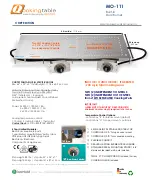
PV500-9 04-2000
(10)
Section 9
TROUBLESHOOTING SUGGESTIONS
GAS BURNER (Con't)
5. CARBON MONOXIDE READINGS ON GAS FIRING
A.
Flame impingement on "cold" heat transfer surfaces caused by excessive firing rate. Reduce firing rate
to correct input volume.
B. Incorrect gas/air ratios. Readjust burner to correct CO
2
/O
2
levels, eliminating all CO formation.
6. GAS HIGH FIRE INPUT CANNOT BE ACHIEVED
A.
Gas company pressure regulator or meter operating incorrectly, not allowing required gas pressure at
burner train inlet. Have gas company correct.
B. Gas cock upstream of train inlet not fully open. Check and correct.
C. Gas line obstructed. Check and correct.
D. Gas train main and/or leak test cocks not fully open. Check and correct.
E.
Gas supply line between gas company regulator and burner inlet too small. Check supply pressure at
meter, determine pressure drop and increase line size as required, or raise supply pressure to
compensate for small line. Do not raise pressure so high that under static (no flow) condition the
pressure exceeds the maximum allowable pressure to the gas train components on the burner.
F.
Burner gas train components sized too small for supply pressure. Increase component size as
appropriate or consult factory.
G. Automatic gas valve not opening fully due to defective operation. Replace gas valve.
H. Orifice (if supplied) too small. Replace with correct size.
I.
On modulating burner, butterfly valve not fully opened. Readjust.
J.
Defective main gas pressure regulator. Replace.
K. Incorrect spring in main gas pressure regulator. Replace as required.
L.
Main gas pressure regulator vent line obstructed. Check and correct.
M. Normally open vent valve (if supplied) not closing when automatic gas valves open. Check to see if
valve is fully closed when automatic valves are open. Replace vent valve, if not closing fully.
Additional troubleshooting information can be found in the Flame Safeguard Control bulletin supplied with the burner.




























